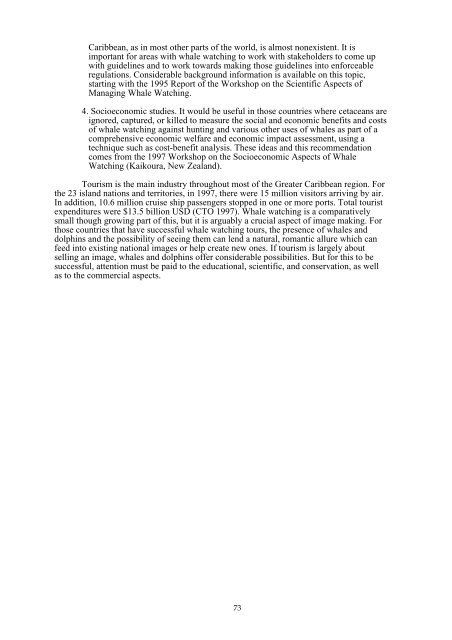The Potential of Whale Watching in the Caribbean: 1999+
The Potential of Whale Watching in the Caribbean: 1999+
The Potential of Whale Watching in the Caribbean: 1999+
Create successful ePaper yourself
Turn your PDF publications into a flip-book with our unique Google optimized e-Paper software.
<strong>Caribbean</strong>, as <strong>in</strong> most o<strong>the</strong>r parts <strong>of</strong> <strong>the</strong> world, is almost nonexistent. It is<br />
important for areas with whale watch<strong>in</strong>g to work with stakeholders to come up<br />
with guidel<strong>in</strong>es and to work towards mak<strong>in</strong>g those guidel<strong>in</strong>es <strong>in</strong>to enforceable<br />
regulations. Considerable background <strong>in</strong>formation is available on this topic,<br />
start<strong>in</strong>g with <strong>the</strong> 1995 Report <strong>of</strong> <strong>the</strong> Workshop on <strong>the</strong> Scientific Aspects <strong>of</strong><br />
Manag<strong>in</strong>g <strong>Whale</strong> <strong>Watch<strong>in</strong>g</strong>.<br />
4. Socioeconomic studies. It would be useful <strong>in</strong> those countries where cetaceans are<br />
ignored, captured, or killed to measure <strong>the</strong> social and economic benefits and costs<br />
<strong>of</strong> whale watch<strong>in</strong>g aga<strong>in</strong>st hunt<strong>in</strong>g and various o<strong>the</strong>r uses <strong>of</strong> whales as part <strong>of</strong> a<br />
comprehensive economic welfare and economic impact assessment, us<strong>in</strong>g a<br />
technique such as cost-benefit analysis. <strong>The</strong>se ideas and this recommendation<br />
comes from <strong>the</strong> 1997 Workshop on <strong>the</strong> Socioeconomic Aspects <strong>of</strong> <strong>Whale</strong><br />
<strong>Watch<strong>in</strong>g</strong> (Kaikoura, New Zealand).<br />
Tourism is <strong>the</strong> ma<strong>in</strong> <strong>in</strong>dustry throughout most <strong>of</strong> <strong>the</strong> Greater <strong>Caribbean</strong> region. For<br />
<strong>the</strong> 23 island nations and territories, <strong>in</strong> 1997, <strong>the</strong>re were 15 million visitors arriv<strong>in</strong>g by air.<br />
In addition, 10.6 million cruise ship passengers stopped <strong>in</strong> one or more ports. Total tourist<br />
expenditures were $13.5 billion USD (CTO 1997). <strong>Whale</strong> watch<strong>in</strong>g is a comparatively<br />
small though grow<strong>in</strong>g part <strong>of</strong> this, but it is arguably a crucial aspect <strong>of</strong> image mak<strong>in</strong>g. For<br />
those countries that have successful whale watch<strong>in</strong>g tours, <strong>the</strong> presence <strong>of</strong> whales and<br />
dolph<strong>in</strong>s and <strong>the</strong> possibility <strong>of</strong> see<strong>in</strong>g <strong>the</strong>m can lend a natural, romantic allure which can<br />
feed <strong>in</strong>to exist<strong>in</strong>g national images or help create new ones. If tourism is largely about<br />
sell<strong>in</strong>g an image, whales and dolph<strong>in</strong>s <strong>of</strong>fer considerable possibilities. But for this to be<br />
successful, attention must be paid to <strong>the</strong> educational, scientific, and conservation, as well<br />
as to <strong>the</strong> commercial aspects.<br />
73
















